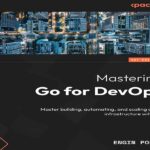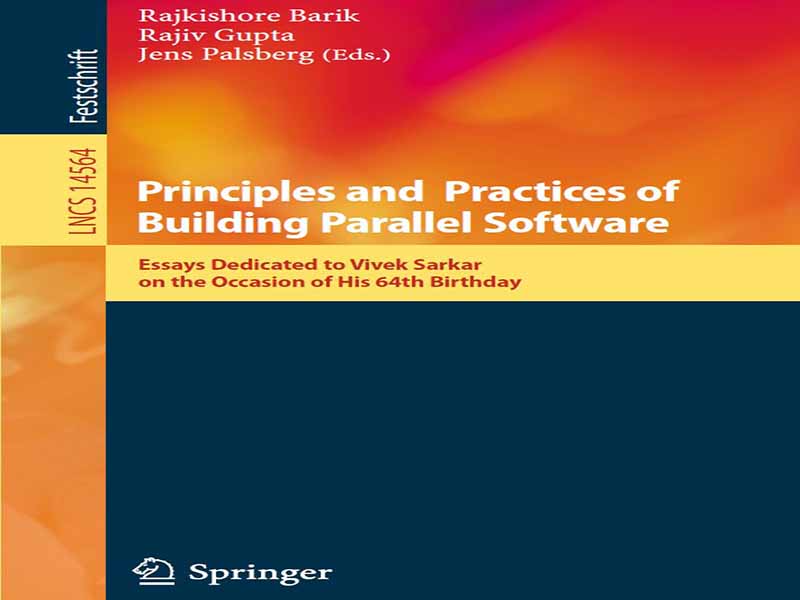- عنوان کتاب: Principles and Practices of Building Parallel Software
- نویسنده: Rajkishore Barik
- حوزه: توسعه نرمافزار
- سال انتشار: 2025
- تعداد صفحه: 142
- زبان اصلی: انگلیسی
- نوع فایل: pdf
- حجم فایل: 6.95 مگابایت
با کمال افتخار این کتاب یادبود را به دانشپژوهی، رهبری و تدریس پروفسور ویوک سارکار، رئیس دانشکده محاسبات دانشگاه جورجیا تک و استاد برجسته دانشکده علوم کامپیوتر، تقدیم میکنیم. عنوان این یادبود، اصول و شیوههای ساخت نرمافزار موازی، بر مشارکتهای دگرگونکننده ویوک در پیشبرد محاسبات موازی تأکید دارد. کار او شامل زبانهای برنامهنویسی، کامپایلرها، سیستمهای زمان اجرا، ابزارهای اشکالزدایی و تأیید برنامهها میشود که همگی برای پرداختن به چالشهای محاسبات با کارایی بالا و مقیاس بزرگ طراحی شدهاند. حرفه ویوک از طریق نوآوریهای پیشگامانه، تخصص فنی و مربیگری متعهدانه، هم شیوههای صنعتی و هم تحقیقات دانشگاهی را عمیقاً شکل داده و او را به عنوان الگویی برای نسلهای دانشمندان کامپیوتر معرفی کرده است. سفر ویوک با کار دکترای بنیادی او در دانشگاه استنفورد تحت راهنمایی پروفسور جان هنسی، چهره برجسته علوم کامپیوتر، آغاز شد. در دهه ۱۹۸۰، زمانی که برنامهنویسی موازی هنوز در مراحل ابتدایی خود بود، ویوک پیشرفتهای چشمگیری در زمانبندی برنامههای موازی ایجاد کرد و چالشهای کلیدی در بهینهسازی وابستگیها را برطرف نمود و پایه و اساس بهینهسازیهای کامپایلر مدرن را که موازیسازی را در مقیاس بزرگ امکانپذیر میکنند، بنا نهاد. ویوک پس از اتمام دوره دکترا، به IBM Research پیوست و در آنجا، تحت راهنمایی فران آلن، با توسعه پارتیشنبندی PART برای موازیسازی خودکار، تجزیه و تحلیل موازنههای هزینه-فایده در حالی که هزینههای سربار و همگامسازی را در نظر میگرفت، در پروژه PTRAN مشارکت داشت. در آزمایشگاههای IBM Santa Teresa، او طراحی و پیادهسازی بهینهساز ASTI را برای کامپایلر XL IBM رهبری کرد و در تبدیلهای پیشرفته برنامه مانند توزیع حلقه، کاشیکاری و جایگزینی اسکالر پیشگام بود و تکنیکهای کامپایلر پیشرفته را به طور یکپارچه در محصول ادغام کرد. از جمله تأثیرگذارترین مشارکتهای ویوک، طراحی زبان برنامهنویسی X10، یک رویکرد شیگرا برای بهبود بهرهوری محاسبات با کارایی بالا است. مقالهی اصلی او، X10: یک رویکرد شیءگرا به محاسبات خوشهای غیریکنواخت [2]، که انتزاعهای برنامهنویسی نوآورانهای را برای سیستمهای موازی و توزیعشده معرفی کرد، جایزهی تأثیرگذارترین مقاله را برای OOPSLA 2005 دریافت کرد و همچنان به شکلدهی تحقیقات در برنامهنویسی موازی مقیاسپذیر ادامه میدهد. ویوک همچنین رهبری توسعهی ماشین مجازی تحقیقاتی جیکس (RVM) [1، 3]، یک JVM متنباز که امکان آزمایش با فناوریهای پیشرفتهی ماشین مجازی را فراهم میکرد و بر تکامل سیستمهای زمان اجرای مدیریتشده تأثیر گذاشت، را بر عهده داشت. این ماشین مجازی توسط بیش از 100 دانشگاه در سراسر جهان مورد استفاده قرار گرفته و به عنوان پایه و اساس بیش از 200 نشریهی تحقیقاتی، 40 پایاننامهی دکترا و 20 دورهی دانشگاهی عمل کرده است. این پروژه در سال 2012 مفتخر به دریافت جایزهی معتبر نرمافزار سیستم SIGPLAN شد.
It is our great pleasure to dedicate this Festschrift volume to the scholarship, leadership, and teaching of Professor Vivek Sarkar, the John P. Imlay, Jr. Dean of the College of Computing at Georgia Tech and a distinguished professor in the School of Computer Science. The title of this Festschrift, Principles and Practices of Building Parallel Software, highlights Vivek’s transformative contributions to advancing parallel computing. His work spans programming languages, compilers, runtime systems, debugging tools, and verification of programs, all designed to address the challenges of high-performance and exascale computing. Through pioneering innovations, technical expertise, and dedicated mentorship, Vivek’s career has profoundly shaped both industry practices and academic research, establishing him as a role model for generations of computer scientists. Vivek’s journey began with his foundational Ph.D. work at Stanford University under the mentorship of Prof. John Hennessy, a luminary in computer science. In the 1980s, when parallel programming was still in its infancy, Vivek made significant advances in the scheduling of parallel programs, addressing key challenges in optimizing dependencies and laying the foundation for modern compiler optimizations that unlock parallelism at scale. After completing his Ph.D., Vivek joined IBM Research, where, under the mentorship of Fran Allen, he contributed to the PTRAN Project by developing the PART partitioner for automatic parallelization, analyzing cost-benefit tradeoffs while accounting for overhead and synchronization costs. At IBM Santa Teresa Labs, he led the design and implementation of the ASTI optimizer for IBM’s XL compiler, pioneering advanced program transformations such as loop distribution, tiling, and scalar replacement, seamlessly integrating cutting-edge compiler techniques into product. Among Vivek’s most influential contributions is the design of the X10 programming language, an object-oriented approach to improve the productivity of high-performance computing. His seminal paper, X10: an Object-Oriented Approach to Non-Uniform Cluster Computing [2], which introduced innovative programming abstractions for parallel and distributed systems, won the Most Influential Paper Award for OOPSLA 2005 and continues to shape research in scalable parallel programming. Vivek also led the development of the Jikes Research Virtual Machine (RVM) [1, 3], an open-source JVM that enabled experimentation with advanced virtual machine technologies and influenced the evolution of managed runtime systems. It has been used by over 100 universities worldwide, serving as the foundation for more than 200 research publications, 40 doctoral dissertations, and 20 universitylevel courses. The project was honored with the prestigious SIGPLAN System Software Award in 2012.
این کتاب را میتوانید از لینک زیر بصورت رایگان دانلود کنید:
Download: Principles and Practices of Building Parallel Software



































نظرات کاربران